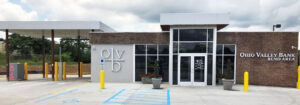In today’s rapidly evolving world, the traditional methods of constructing buildings have undergone a paradigm shift. The emergence of prefabricated commercial buildings has revolutionized the construction industry, offering cost-effective, efficient, and sustainable solutions. One of the most intriguing applications of this innovative construction approach is the establishment of banks. This article delves into the possibilities and advantages of constructing a bank using prefabricated commercial buildings, exploring the potential benefits, design flexibility, sustainability aspects, and the overall future outlook of such an endeavor.
Introduction to Prefabricated Commercial Buildings
Prefabrication involves assembling building components off-site before transporting them to the intended location for final assembly. This technique deviates from conventional on-site construction by streamlining the building process, reducing construction time, and minimizing material waste. Prefabricated commercial buildings have gained traction across various industries due to their versatility, cost-effectiveness, and sustainability.
The Emergence of Prefabricated Banks
The concept of employing prefabricated structures for banks is an innovative stride in the financial sector. Banks are vital institutions in any community, requiring robust, secure, and aesthetically pleasing structures to operate efficiently. Prefabricated commercial buildings offer an array of advantages that align perfectly with the stringent requirements of a modern-day bank.
Advantages of Prefabricated Banks
Speedy Construction:
Prefabricated buildings significantly reduce construction timelines. Banks can be operational much faster than with traditional construction methods, enabling quicker service deployment to communities in need.
Cost Efficiency:
Cost-effectiveness is a significant advantage of prefabricated structures. The controlled environment of off-site construction minimizes material waste, labor costs, and construction delays, resulting in overall cost savings.
Customization and Design Flexibility:
Contrary to common misconceptions, prefabricated buildings offer substantial design flexibility. Banks can be customized to suit specific architectural preferences, security requirements, and branding elements, ensuring a unique identity while maintaining functionality.
Quality Assurance:
Centralized manufacturing facilities for prefabricated components ensure stringent quality control measures. This guarantees that the bank’s structure meets high-quality standards, adhering to safety and regulatory guidelines.
Sustainability and Eco-Friendliness:
Prefabricated construction promotes sustainability by minimizing material waste, reducing energy consumption, and often incorporating eco-friendly materials and energy-efficient designs. This aligns with the growing emphasis on environmental responsibility in modern construction practices.
Designing a Prefabricated Bank
The design phase of a prefabricated bank involves meticulous planning to ensure that all aspects of the bank’s functionality, security, aesthetics, and customer experience are seamlessly integrated.
Security Measures:
Banks require robust security measures. Incorporating advanced security systems and features within the prefabricated structure during the manufacturing phase ensures a secure environment for both customers and assets.
Customer Experience and Functionality:
Design considerations for a prefabricated bank include optimizing the layout for customer convenience, ensuring easy access to services such as ATMs, teller counters, consultation areas, and private meeting rooms.
Branding and Aesthetics:
Customization options allow banks to incorporate branding elements into the structure’s exterior and interior design. This helps create a distinctive identity while aligning with the bank’s visual aesthetics and corporate values.
Sustainability and Green Initiatives
Prefabricated banks can embrace sustainable practices by utilizing eco-friendly materials, incorporating energy-efficient designs, and integrating renewable energy sources such as solar panels. Additionally, the minimized waste generation during construction aligns with sustainability goals, reducing the environmental impact.
The Future of Prefabricated Banks
The utilization of prefabricated commercial buildings in the banking sector represents a forward-looking approach to construction. As technology continues to advance, innovations in prefabrication techniques will further enhance the feasibility and versatility of constructing banks using this method.
Technological Advancements:
Advancements in construction technologies, such as 3D printing, modular designs, and smart building systems, will revolutionize the prefabricated construction landscape. These innovations will enable even more sophisticated and efficient bank structures.
Expansion and Accessibility:
Prefabricated banks offer scalability, allowing for easy expansion or relocation as the banking institution grows or adapts to changing community needs. This flexibility ensures continued accessibility to financial services in various regions.
Community Impact:
The rapid deployment of prefabricated banks can have a significant positive impact on communities, especially in underserved areas or regions affected by natural disasters. Quick establishment of banking services contributes to economic growth and resilience.
Conclusion
The integration of prefabricated commercial buildings in the banking industry signifies a progressive shift toward efficient, cost-effective, and sustainable construction methods. Prefabricated banks offer myriad benefits, including rapid construction, cost efficiency, design flexibility, enhanced security, and sustainability. As technology evolves, the future holds immense potential for further advancements in prefabricated construction techniques, fostering the growth and accessibility of banking services while positively impacting communities worldwide. The fusion of innovative prefabrication methods with the fundamental needs of the banking sector marks a promising path toward a more resilient and adaptable future.
As the construction industry embraces these advancements, the realization of prefabricated banks stands as a testament to the limitless possibilities of modern construction practices, revolutionizing the way essential institutions are built and serving as a beacon of progress in the financial landscape.
Related posts:
- Show Your Appreciation: 20 Thoughtful Gift Ideas for Bank Employees
- Enhancing Banking Excellence: The Crucial Role of Design and Drafting Services
- Why Richmond, VA Banks Should Engage an Employment Lawyer: Protecting Rights and Navigating Legal Complexities
- How to Secure a Business Loan for Your Pool Repair Business in Austin


